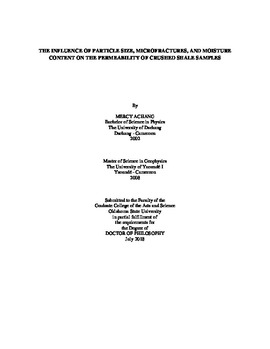| dc.contributor.advisor | Pashin, Jack C. | |
| dc.contributor.author | Achang, Mercy | |
| dc.date.accessioned | 2019-03-22T18:57:09Z | |
| dc.date.available | 2019-03-22T18:57:09Z | |
| dc.date.issued | 2018-07 | |
| dc.identifier.uri | https://hdl.handle.net/11244/317658 | |
| dc.description.abstract | Permeability, porosity and pore size distribution in shale are essential for the evaluation and optimization of hydrocarbon recovery. The absence of standardized procedures for measuring permeability is thought to result in the lack of repeatable and accurate permeability estimates for crushed shale since the permeability of the same sample measured by different laboratories can vary by orders of magnitude. Also, changes in stress, moisture content, microfractures whether natural or induced by crushing, and hydrocarbon content during retrieval of samples from the subsurface to the laboratory influence permeability as well. Moisture loss results from transportation storage of samples for hours to decades before permeability analysis. This is a fundamental preservation problem which can be solved by normalizing or restoring moisture. This research investigates (1) the relationship between crushed particle size and crushed-rock pressure-decay permeability, (2) microfractures in particles of different sizes, (3) the mass of sample required for accurate permeability measurements with a shale matrix permeameter (4) permeability in as-received and moisture equilibrated crushed shale samples and (5) pore size distribution in crushed and whole-rock shale samples. The methods used are; core description scanning electron microscopy, helium porosimetry, and crushed-rock permeability. Results suggest that matrix permeability increases with particle size, particles of all sizes in the Woodford Shale core studied contain microfractures. Permeability values are dependent on the technique used for permeability analysis, and pressure decay curves have three distinct segments: hyperbolic, exponential and pseudo-steady state. Replicate sample runs indicate that permeability measurements are more repeatable for moisture equilibrated samples than as-received samples across a range of particle sizes. | |
| dc.description.abstract | According to pore size distributions determined by nuclear magnetic resonance (NMR), an increase in the area under the T2 distributions is suggested to be related to artificial pore space created by crushing the shale. Both whole rock samples and crushed shale have unimodal and bimodal T2 distributions. Pore size distributions determined from low pressure and temperature nitrogen sorption are dominated by mesopores where a large quantity of gas is sorbed. Pore shapes are slitlike based on NMR and SEM analysis. | |
| dc.format | application/pdf | |
| dc.language | en_US | |
| dc.rights | Copyright is held by the author who has granted the Oklahoma State University Library the non-exclusive right to share this material in its institutional repository. Contact Digital Library Services at lib-dls@okstate.edu or 405-744-9161 for the permission policy on the use, reproduction or distribution of this material. | |
| dc.title | Influence of particle size, microfractures, and moisture content on the permeability of crushed shale samples | |
| dc.contributor.committeeMember | Grammer, Michael G. | |
| dc.contributor.committeeMember | Puckette, James O. | |
| dc.contributor.committeeMember | Clark, Peter | |
| osu.filename | Achang_okstate_0664D_15928.pdf | |
| osu.accesstype | Open Access | |
| dc.type.genre | Dissertation | |
| dc.type.material | Text | |
| thesis.degree.discipline | Geology | |
| thesis.degree.discipline | Geology | |
| thesis.degree.grantor | Oklahoma State University | |
| thesis.degree.grantor | Oklahoma State University | |
